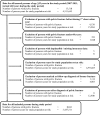Epidemiology of Pelvic Fractures in Germany: Considerably High Incidence Rates among Older People
- PMID: 26418971
- PMCID: PMC4587805
- DOI: 10.1371/journal.pone.0139078
Epidemiology of Pelvic Fractures in Germany: Considerably High Incidence Rates among Older People
Abstract
Epidemiological data about pelvic fractures are limited. Until today, most studies only analyzed inpatient data. The purpose of this study was to estimate incidence rates of pelvic fractures in the German population aged 60 years or older, based on outpatient and inpatient data. We conducted a retrospective population-based observational study based on routine data from a large health insurance company in Germany. Age and sex-specific incidence rates of first fractures between 2008 and 2011 were calculated. We also standardized incidence rates with respect to age and sex in the German population. Multiple Poisson regression models were used to evaluate the association between the risk of first pelvic fracture as outcome and sex, age, calendar year and region as independent variables. The total number of patients with a first pelvic fracture corresponded to 8,041 and during the study period 5,978 insured persons needed inpatient treatment. Overall, the standardized incidence rate of all first pelvic fractures was 22.4 [95% CI 22.0-22.9] per 10,000 person-years, and the standardized incidence rate of inpatient treated fractures 16.5 [16.1-16.9]. Our adjusted regression analysis confirmed a significant sex (RR 2.38 [2.23-2.55], p < 0.001, men as reference) and age effect (higher risk with increasing age, p < 0.001) on first fracture risk. We found a slight association between calendar year (higher risk in later years compared to 2008, p = 0.0162) and first fracture risk and a further significant association with region (RR 0.92 [0.87-0.98], p = 0.006, Westfalen-Lippe as reference). The observed incidences are considerably higher than incidences described in the international literature, even if only inpatient treated pelvic fractures are regarded. Besides which, non-inclusion of outpatient data means that a relevant proportion of pelvic fractures are not taken into account. Prevention of low energy trauma among older people remains an important issue.
Conflict of interest statement
Figures
References
-
- Balogh Z, King KL, Mackay P, McDougall D, Mackenzie S, Evans JA et al. The Epidemiology of Pelvic Ring Fractures: A Population-Based Study. J Trauma 2007;63: 1066–1073. - PubMed
-
- Kannus P, Palvanen M, Niemi S, Parkkari J, Järvinen M. Epidemiology of Osteoporotic Pelvic Fractures in Elderly People in Finland: Sharp Increase in 1970–1997 and Alarming Projections for the New Millenium. Osteoporos Int 2000;11: 443–448. - PubMed
-
- Kelsey JL, Prill MM, Keegan TH, Quesenberry CP Jr, Sidney S. Risk Factors for Pelvis Fracture in Older Persons. Am J Epidemiol 2005;162: 879–886. - PubMed
-
- World Health Organization. Global Health and Aging. National Institute on Aging, National Institute of Health; 2011; Online Publication; Available from: http://www.who.int/ageing/publications/global_health/en/. Accessed January 7, 2015
Publication types
MeSH terms
LinkOut - more resources
Full Text Sources
Other Literature Sources
Medical



